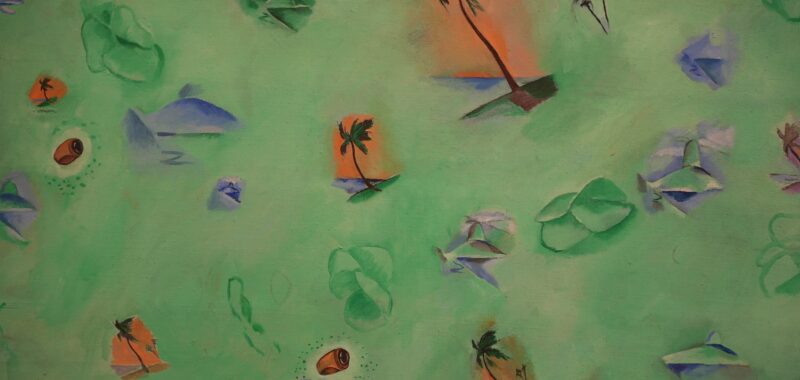Suellen Rocca was one of the original six artists who comprised the Hairy Who. The Chicago artist group exhibited three times in the city between 1966 and ’68, then, in 1969, Walter Hopps curated the final Hairy Who show at the Corcoran Gallery in Washington, DC. Nearly six decades later, what continues to impress me about these artists is that they each developed an individual visual language, and started tracing this trajectory at the outset of their careers. While they may have shared sources of inspiration, their art was as different from one another’s as Spanish and Italian.
The 20 paintings, drawings, and objects in the exhibition Suellen Rocca: Good Things and Bad Things at Matthew Marks Gallery span 1964 to 2014, nearly her entire career (she died in 2020), and range in size from more than six feet tall and five feet wide, to paintings on small leatherette and plastic purses. By 1964, Rocca had developed her foundational visual language, which can be described as a kind of “picture writing,” in which a simplified graphic image of a narrow bed is used to convey some kind of meaning. The repeated placement of a hand-painted figure with other figures establishes a pictographic field, inviting the viewer to read into it. Deciphering Rocca’s artworks is part of the pleasure of encountering them.

Among Rocca’s primary visual sources are mid-century ads — those reflections and solutions for the nation’s middle-class, conformist desires: get married, buy a diamond ring, raise a family. When Rocca finally homed in on that subject, she added surprising elements to her compositions, such as a palm tree, a person asleep inside a bubble, at once protected and isolated, and two open hands reaching through slits, as if they are inside a headless human body, the latter being one of the most unsettling of her linear pictures.
“Untitled” (2020), which features this image in one of its four abutted panels, pushes us to a more ominous reading of seemingly benign iconography — an empty bed, birds perched or in flight, a pair of legs, and a house — transporting us into an area of speculation. An untitled watercolor and graphite work (also 2020) composed of four rows of repeated items similarly unsettles familiar imagery. The top three rows show a house, a nude woman on a large rock, and a hand alternating with a leaf. For the bottom row, Rocca renders a body melting on a bed.

Along with these enigmatic paintings, in which the repetition of images is essential to the composition, Rocca created others that don’t fit into this mold, such as “Lamp Poem” (c. 1969), whose edge is made of pleated fabric. If she had repeated this in several pieces, she would have diminished the power of this work. On the shade of a blue lamp at the center, Rocca has depicted a house with smoke coming out of its chimney. Lines extend out of both the house and the lampshade, denoting light.
In each corner of the painting, Rocca has written out “ohh,” “ahh,” or “mmm.” What do these pause fillers mean? What do the black lines radiating from “mmm,” and matching those of the house and lamp, signify? What appears at first to be a painting of a lamp becomes strange and incongruous the longer we look at it. Is it about collective aspirations for domesticity and comfort in the United States?

In the mostly black and white drawing “Hidden Danger Lady” (1984–2012), Rocca portrays a creature sitting cross-legged, with space made by overlapping legs and oversized pink hands, the only color in the work. The pink differentiates the space established by the figure’s legs from the black and white ground, complicating the reading of this drawing.
In this and “Lamp Poem,” Rocca broadens her body of work, and conveys her creative breadth and her restlessness to do something new. If this drawing is any indication of what she can achieve with graphite, an exhibition of drawings by her or all of the Hairy Who artists, for whom drawings form a distinct body of work, is warranted.
In her pictographic works, especially those with domestic images (e.g., beds, houses, and diamond rings), Rocca evokes a conflicted world. The objects, and the successful middle-class life they represent, is both desired and stultifying. Rocca could see the banality of the American Dream.






Suellen Rocca: Good Things and Bad Things continues at Matthew Marks Gallery (523 West 24th Street, Chelsea, Manhattan) through April 19. The exhibition was organized by the gallery.

